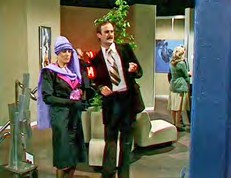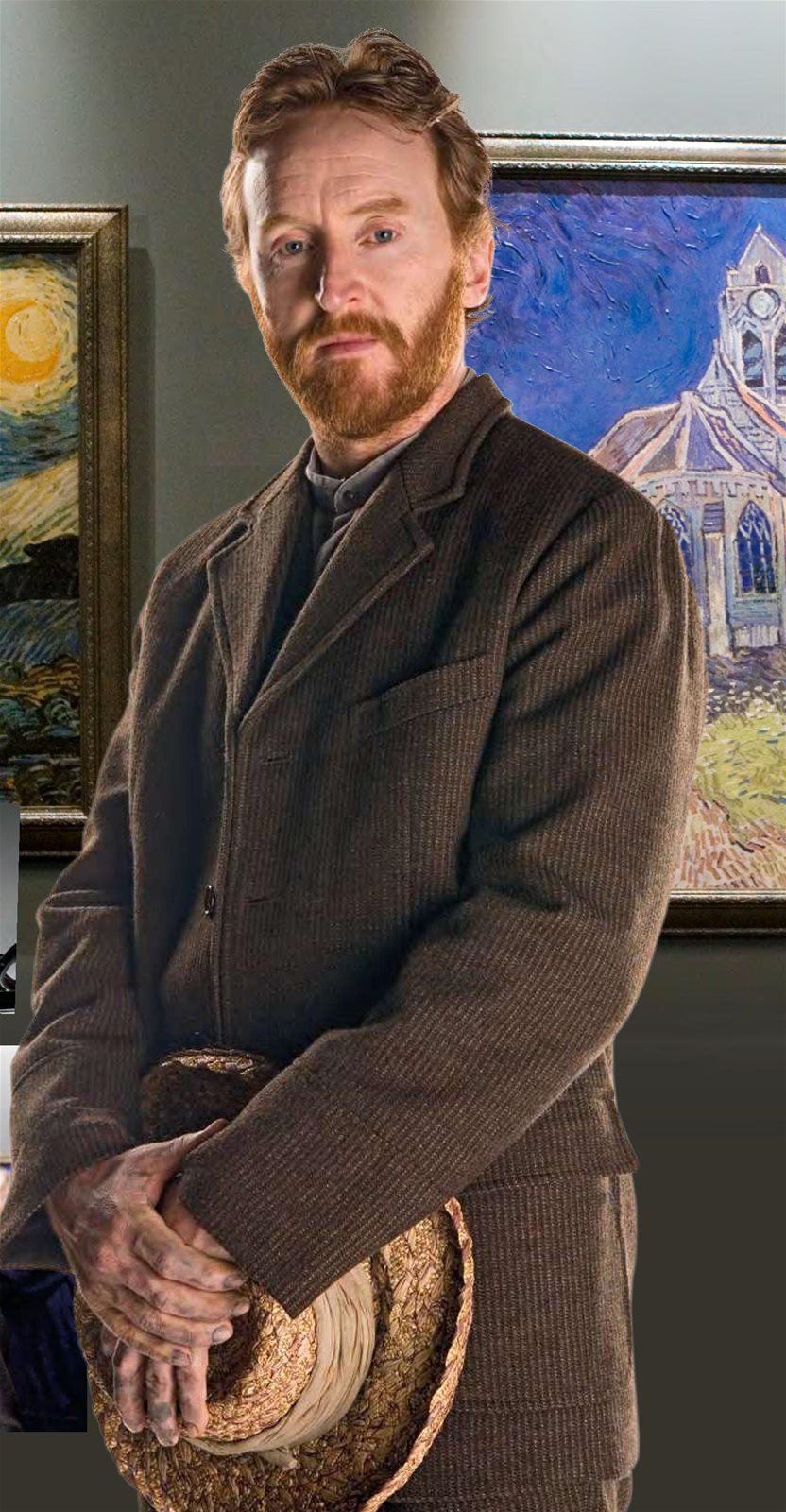
Left: The Doctor (Matt Smith) listens as Dr Black (Bill Nighy, uncredited) describes Vincent’s place in history.
Thirty-six minutes into Vincent and the Doctor, with the blind, lumbering Krafayis dead in the church crypt at Auvers, the tortured artist Vincent Van Gogh (Tony Curran) bids the Doctor (Matt Smith) goodbye: “We have fought monsters together and we have won. On my own, I fear I may not do as well…”
But only one of those monsters is dead; the other is undefeated. Perhaps to salvage some kind of victory, despite the certainty that Vincent remains destined to die by his own hand, Richard Curtis – one of the most successful screenwriters of all time – has the Time Lord transport Vincent to an exhibition of his work at the Musée d’Orsay in 2010. There, Dr Black (played by Bill Nighy, making the greatest uncredited appearance of an instantly recognisable actor playing an art critic in a Parisian gallery in Doctor Who, ever, despite significant competition) uses 111 words (not 100), to describe Vincent’s place as the “most beloved” painter of all time: “Pain is easy to portray, but to use your passion and pain to portray the ecstasy and joy and magnificence of our world – no one had ever done it before…”
At the time of broadcast, some newspaper columnists, including Sue Carroll in the Mirror, were scathing about the BBC Action Line number being flashed up at the end, for viewers affected by the issues raised – a first for Doctor Who. The Guardian’s Sam Wollaston played the cynic, too: “Then there’s a song, the kind that people hold their lighters in the air to at a festival… And I think I may throw up. Except there’s something stopping me, in my throat… a lump! Oh God, it’s got to me, against my better judgment and my will.
He does that, Curtis, it just creeps up on you.”
Or perhaps that’s just what happens when you put passion and pain and ecstasy and joy and magnificence into Doctor Who.

Two arty types (Eleanor Bron and John Cleese, uncredited) critique the TARDIS, having found it installed in a Parisian gallery in City of Death (1979).

Vincent Van Gogh (Tony Curran) with his Church at Auvers (1890).

The Athlete album Tourist (2005) contains the anthemic Chances, heard during the episode.
First broadcast Saturday 5 June 2010
Something in a wheatfield causes crows to scatter – as observed by a painter, working at his easel.

00m 13s The artist is Vincent Van Gogh, working on Wheatfield with Crows – a canvas painted between 6 and 10 July 1890, in the last few weeks before his death from a selfinflicted gunshot wound. We’ll see, however, that the majority of this episode occurs in the first few days of June, around the time that Van Gogh painted The Church at Auvers. Which raises a possibility we’ll return to… More than a century later, Wheatfield with Crows hangs in a gallery at the Musée d’Orsay – on temporary loan, we presume, since it can normally be viewed at the Van Gogh Museum in Amsterdam. While Van Gogh expert Dr Black (Bill Nighy, uncredited) describes the painting as part of the “astonishing artistic outpouring” of the artist’s final months, the Doctor and Amy Pond (Karen Gillan) enter – with Amy wondering why the Doctor’s being so nice to her: “These places you’re taking me. Arcadia, the Trojan Gardens, now this.
I think it’s suspicious.” Stage directions indicated: “The Doctor is definitely guilty about what he knows about Rory’s death and she doesn’t” – since Amy’s fiancé was killed by a Silurian weapon at the end of the previous episode, Cold Blood, whereupon his body was absorbed by time energy, erasing him from history (and Amy’s memory, too).
The Arcadia mentioned can’t be Gallifrey’s second city (as mentioned in Doomsday, 2006), because Gallifrey is currently presumed to have been lost in the Time War. It might, however, be the source of the “Arcadian diamond” discussed in the Torchwood episode Kiss Kiss, Bang Bang (2008) – “the rarest gem in the Damascene Cluster”, apparently – or the pastoral paradise of Greek myth. Likewise, the gardens in question might well be those of the bronze age city of Troy, its destruction witnessed by the Doctor in The Myth Makers (1965). Perhaps the Doctor is reverting to a prior tactic here, having sought to cheer up his surviving companions following the death of a TARDIS shipmate by trying to take them to an Earthly exhibition at the start of TimeFlight (1982).